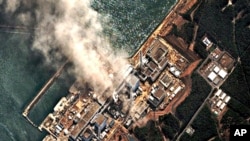The nuclear emergency in Japan has renewed debate about the safety of nuclear power in the Asia Pacific, possibly the world’s most natural-disaster prone region. Southeast Asia has no working nuclear power plants, but most countries there plan to develop nuclear power despite the emergency.
Indonesia, Malaysia, Thailand, and Vietnam plan to build nuclear power plants in the next decade and others in Southeast Asia hope to follow them.
But the nuclear emergency caused by the earthquake and tsunami in Japan has raised concerns about the safety of developing nuclear power, especially in countries vulnerable to natural disasters. The Asia Pacific region is every year struck by earthquakes, tropical storms, monsoon floods and landslides.
Following the disaster in Japan, some officials and activists in the region are urging a re-thinking of pursuing nuclear energy.
Vietnam Atomic Energy Commission Chairman Vuong Huu Tan says his country is watching the emergency in Japan closely and is aware of public concerns. But he says they do not expect it to affect their plans to build at least eight nuclear plants.
Vuong says they will use the latest nuclear technology, which he says will be safer than the older technology used at Japan’s Fukushima Daiichi nuclear plant.
"We will choose the advanced nuclear power technology,” Vuong said. “It means maybe we choose the technology of generation three or three-plus. It is very good when the accident like the earthquake in Japan you see."
Vuong says they plan to begin construction of Vietnam’s first nuclear-power plant in three years. Thailand plans to build up to five nuclear power plants by 2025.
Following the emergency in Japan, the Thai government said it would also take into account concerns about nuclear safety as it became more of a public focus.
But Thai government spokesman Panitan Wattanayagorn says it would not delay their nuclear power development.
"Until we know for sure what happened in Japan, I think several governments may require more information on this issue,” said Panitan. “So, I think 'yes', certainly it raises some concerns, but these concerns are not new. Hopefully, our committee who are working on this issue will come up with a comprehensive picture of this."
Panitan says if there is any delay in Thailand’s nuclear-power plans it would be from technical difficulties and feasibility studies and not in reaction to Japan’s nuclear emergency.
Southeast Asia specialist Carl Thayer, of Australia’s University of New South Wales, says the emergency in Japan may cause a review of safety planning for nuclear risks in some countries. But he says Southeast Asia’s fast-growing demand for power means it has few alternatives to pursuing nuclear energy.
"You have hydro power, you can go to bio fuels, you can use wind power,” Thayer said. “But the growing size of the economies, rise in consumption, people moving up the scale with gadgets and things in their homes that consume energy, all that would have to be held in advance not to lead to these massive demands for energy."
Built in the 1980's, the Philippines’ Bata'an plant is the only nuclear power facility in Southeast Asia, but because of concerns about earthquakes and a nearby volcano it was never used. The government, however, is considering reviving the plant in order to meet its energy needs.








